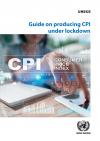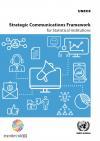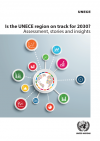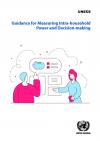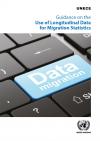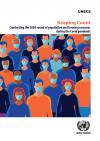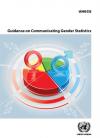Publications
Displaying Results 21 - 40 of 256
- English
The lockdown that followed the outbreak of the Covid-19 pandemic in 2020 posed unprecedented challenges to produce the consumer price index (CPI) in many countries. The closing of retail outlets and difficulties with collecting prices from outlets that remained open caused significant drops in the number of collected prices. Statistical offices, therefore, had to explore new data sources and
- English
Strategic communication is a relatively new concept for most statistical organizations, which have traditionally focused their efforts and resources on dissemination practices and systems. A strategic communication function can guide the development and implementation of a communication strategy. This has particular relevance for the world of official statistics, where communication and
- English
The UNECE region has been among the hardest hit by the COVID-19 pandemic. In addition to the devastating impact on lives and health, countries are suffering heavy socio-economic consequences: GDP in the region is projected to fall by 6-7% in 2020 with significant discrepancies across countries; unemployment has risen significantly despite support measures; trade, transport and mobility across
- English
This report provides a progress assessment on the Sustainable Development Goals (SDGs) in the region of the United Nations Economic Commission for Europe (UNECE), based on the data available in the United Nations Global SDG Indicators Database and on the statistical methodology commonly used by all five United Nations regional commissions.
The assessment identifies targets on which the overall
- English
Unequal power relations operate not only in the public world but also in the private sphere, within households. This Guidance has been developed to support national statistical offices in developing ways to measure power in the private sphere, looking at who usually makes decisions about a variety of matters, from routine grocery shopping to saving up for a car, and from seeing a doctor to
- English
As the number of international migrants has grown, it is becoming increasingly important for the public and policymakers to understand migratory flows and the impact of migration on individuals, families, societies and economies. For this, it is necessary to look at change over time, as underscored in the Global Compact for Safe, Orderly and Regular Migration. A longitudinal approach where
- English
Measuring the activities of multinational enterprise groups is one of the major challenges facing producers of official statistics today. Sharing data nationally and internationally on the activities of multinational enterprise groups has become necessary to ensure the high quality of official statistics.
This Guide follows in the steps of the two previous guides on globalization - The Impact of
- English
When the Covid-19 pandemic broke out in March 2020, preparations for the 2020 round of population and housing censuses were well underway in countries across the UNECE region: some were already in the field, while the majority were in the advanced stages of planning for a 2021 census.
The impacts of the pandemic on census-taking have been wide ranging; from the need for social distancing in
- English
This publication provides guidance on applying various approaches to data disaggregation for measuring poverty and aims to improve the international comparability of poverty statistics. Regardless of how accurate the national measures of poverty are, their usefulness will be limited if they mask existing disparities within societies.
The introductory Chapter 1 lays down the
- English
Gender statistics, like statistics on any other topic, are valuable to users only if they are easily found and accessible, and if users find them relevant and easy to understand. National statistical offices must take extra care when communicating gender statistics to balance the need to remain impartial with the obligation to produce relevant data to inform policymaking and answer the
- English
This Guide introduces seasonal adjustment and gives practical guidance to national statistical offices in producing seasonal adjusted monthly or quarterly time series covering all steps in the production process, from the evaluation of the original data series to the dissemination and communication of the seasonally adjusted series. The Guide can be used in introducing new staff to seasonal
- English
The population census is not just about counting how many people live in a country, but also providing information about age, sex, and other key characteristics that allow countries to paint a picture of how different groups, with different needs, are spread out across the country. In fact, the census provides the foundation for many statistics that help us make informed decisions
- English
The idea of viewing human knowledge and abilities as an asset and to estimate its value is not new but has gained more prominence in recent years. ln 2016, the United Nations Economic Commission for Europe (UNECE) published the "Guide on Measuring Human Capital"with the objective of pursuing the conceptual development of human capital measurement and with a particular focus on
- English
This report presents a selection of examples of the impact of UNECE’s work in support of its member States for the implementation of the 2030 Agenda for Sustainable Development over the course of 2019.It shows how UNECE’s policy advice, practical norms and capacity building activities have helped countries and the people in the region.
- English
Many countries and regions are facing two increasingly stark trends: rapid urbanization and a growing number of natural disasters caused by climate change-related hazards. Combined, they substantially increase the risk to which many people are exposed.
The increasing number and magnitude of disasters and their impacts on people, the economy and the environment have led to the adoption of global
- Pусский
Statistics on social and demographic topics are usually produced from surveys of private households. People living in institutions are often excluded because it can be complicated and expensive to identify and sample the institutions and their residents.
But populations across the UNECE region and throughout the world are growing older, and for many countries this means that the population of
- English
Statistics on social and demographic topics are usually produced from surveys of private households. People living in institutions are often excluded because it can be complicated and expensive to identify and sample the institutions and their residents.
But populations across the UNECE region and throughout the world are growing older, and for many countries this means that the population of
- English
This report reviews the situation and trends in progress towards the Sustainable Development Goals (SDGs) through the lens of 49 selected indicators under each of the 17 SDGs. Indicators were selected based on their relevance to the UNECE region and availability of data. For the most part, the report relies on the data available in the United Nations Global SDG Database as of 20 December 2019.
- English
Leading, composite and sentiment indicators make it possible for official statistics to shed new light on aspects of the economy and the society, for instance through compilation of leading indicators on the economic development or composite indicators measuring the well-being of households.This publication gives guidance to statistical offices that produce or consider producing leading,
- English
UNECE is committed to supporting its member States for the implementation of the 2030 Agenda for Sustainable Development. This report presents a selection of examples of the impact of its work in 2018.It shows how UNECE’s policy advice, practical norms and capacity building activities have helped countries and the people in the region.Symbol: ECE/INF/2019/1


